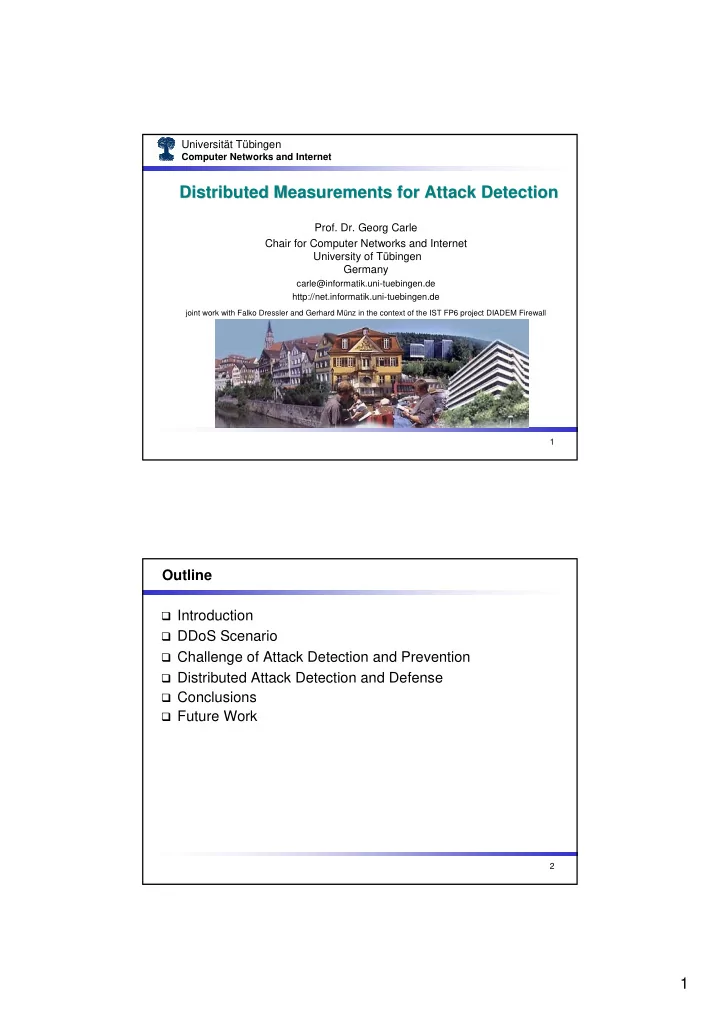

Universität Tübingen Computer Networks and Internet Distributed Measurements for Attack Detection Distributed Measurements for Attack Detection Prof. Dr. Georg Carle Chair for Computer Networks and Internet University of Tübingen Germany carle@informatik.uni-tuebingen.de http://net.informatik.uni-tuebingen.de joint work with Falko Dressler and Gerhard Münz in the context of the IST FP6 project DIADEM Firewall 1 Outline � Introduction � DDoS Scenario � Challenge of Attack Detection and Prevention � Distributed Attack Detection and Defense � Conclusions � Future Work 2 1
DDoS Scenario – Location of Attack Detection and Defense Close to Attacker Detection difficult Close to Victim Defense easier Detection simpler Defense more difficult Attacker Victim Within the network Difficulty of Detection? Difficulty of Defense? => DDOS Defense Service? 3 Distributed Attack Detection Scenario M Network Monitor DS DS Detection System Information exchange Measurement Data DS Attacker M M M M Victim M DS 4 2
Attack Detection Methods � Knowledge-based Detection � Search for known attack characteristics • Known packet sequences • known bit sequences in packets • known errors � Disadvantage: not suitable to detect new types of attacks � Anomaly detection � Search for deviation from regular behaviour • Statistical tests • Data analysis (analysis of standard deviation, cluster analysis,...) • Pseudo tests (with unspecifiable error range) • Methods from pattern recognition (neural networks, Bayes networks,...) � Disadvantage: high probability of false positives, false negatives 5 Defense Initiation F : filter/firewall Notification DS RS Detection System DS : response system Configuration RS F F 6 3
Challenge of Attack Detection � Characteristics of DDoS Attacks � Synchonisation of senders � communication among attackers � Individual senders send traffic not identifiable as attack itself � Aggregation makes attack effective and detectable � Forged addresses, masquerade etc. make detection attackers difficult � Challenges � Control traffic among attackers frequently remains undetected � Detection requires detecting aggregates � Similarity of legitimate traffic and attack traffic � Identifying attackers is difficult, requires trace-back - possibly across domains � Scalability to high speeds 7 Taxonomy of Detection Systems � 3 types of distributed detection systems: Centralized Control Centralized Database Subsystem Database Alerts Alerts Alerts Control Detection Detection Autonomous Autonomous Cooperative Cooperative Subsystem 1 Subsystem 3 Subsystem 1 Subsystem 3 Subsystem 1 Subsystem 3 Autonomous Detection Cooperative Subsystem 2 Exchange of Subsystem 2 Subsystem 2 Cooperative Information (1) Distributed detection system (2) Distributed detection system (3) Distributed detection system with autonomous subsystems with cooperative autonomous with interdependent subsystems subsystems 8 4
Existing Distributed Attack Detection Systems � EMERALD, Stanford Research Institute (SRI), 1997 � Distributed detection and response system � Primarily conceived to detect host-based intrusions � Employs interdependent monitors on multiple hierarchical levels � Prelude IDS, Open-source project, since 1998 � Three functional components: sensors, managers, countermeasure agents � Supports various types of sensors (host-based and network-based) � D-WARD, Peter Reiher/Jelena Mirkovic, UCLA, 2002 � System of independent subsystems � Each subsystem controls traffic originating from a source-end network � COSSACK, Christos Papadopoulos, ISI, 2003 � Uses so-called watchdogs located at edge networks to detect and trace ongoing attacks 9 Overview of Distributed Detection Systems System Type of Detection methods Relationship detection between subsystems EMERALD host-based knowledge-based interdependent + anomaly detection Prelude host-based and knowledge-based interdependent IDS network-based detection D-WARD network-based anomaly detection autonomous COSSACK network-based anomaly detection cooperative CATS network-based knowledge-based cooperative + anomaly detection 10 5
Cooperating Autonomous Detection Systems (CATS) Concept and Benefits � Separation of monitoring and detection � Utilization of a distributed monitoring environment � Deployment of multiple independently working autonomous detection systems � Self-X properties of the detection systems � Self-configuration � Self-maintainance � Self-optimisation � Improved detection performance through cooperation between multiple detection systems � Combination of knowledge-based and anomaly detection techniques using both local and global context information � Export of packet data and flow statistics utilizing standardized protocols, e.g. IPFIX and PSAMP 11 Monitor Architecture PSAMP Netflow Events & Events & Data Data Characterization Characterization Knowledge-based IDS Anomaly detection � looking for known � looking for unusual behavior signatures and without any precognition misbehavior - comparing long-time behavior to short-time behavior - maintaining different profiles (per destination, aggregate,...) Potential Techniques: - statistical tests, neural networks, Bayes networks Statistical measures - bit rate, packet rate, # of connections,... - gathered per aggregate or single flow Packet monitoring & sampling Raw Packet PSAMP Netflow Data Data Data 12 6
Interactions of Autonomous Detection Systems � Autonomous detection systems exchange two types of information in order to enable attack detection in global context: � Selected monitoring data (sampled packets and flow statistics) � Information about suspicious network traffic 13 Assessment EMER- Prelude D-WARD COSS- CATS ALD IDS ACK Attack Local context yes yes yes yes yes detection Global context no (host- no no yes yes based) Knowledge-based yes yes no no yes detection Anomaly yes no yes yes yes detection Autonomous behavior no no yes yes yes Distributed Sep. of monitoring no no no no yes intelligence & detection Distributed yes partly no no yes detection 14 7
Conclusions � Attack detection and defense is an important application are that benefits from self-organisation � Cooperating Autonomous Detection Systems (CATS) provides network-based attack detection based on the following main principles: � Distributed monitoring and detection � Cooperation between autonomous detection systems � Benefits: � Scalability by adapting monitoring and detection to the current load � Increases detection performance by adding global context information to the detection process � Robustness due to self-X properties � Next Steps � Implementation of a proof-of-concept prototype in the context of the EU project Diadem Firewall (EU FP6 Project IST-2002-002154) � Performance evaluation and comparison with competing systems 15 8
Recommend
More recommend